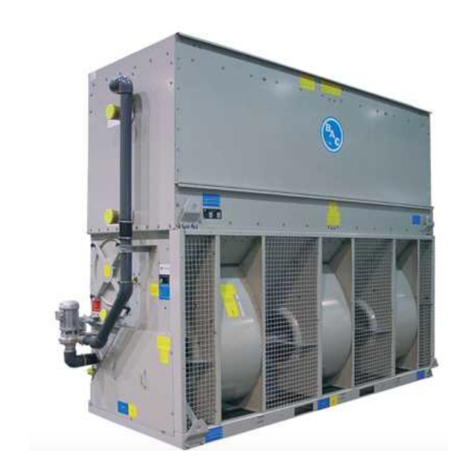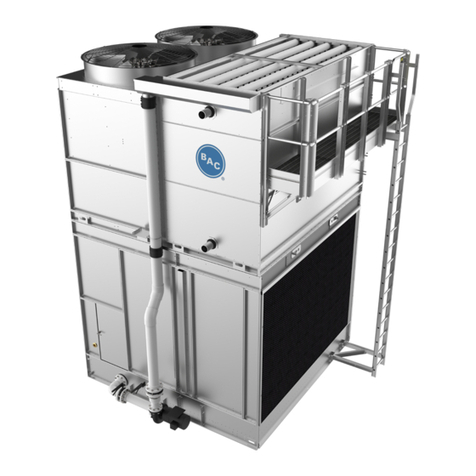
WWW.BALTIMOREAIRCOIL.COM
8
• Units (with coils) that have been installed and operated should remain filled. If the
unit is stored in a freezing climate, the coil must be protected from freezing. For
protection against coil freeze-up, BAC recommends the use of an inhibited glycol
solution. If protecting the coils with glycol is not possible, the galvanized steel coils
should be drained completely and capped once as much water and moisture is
removed from the coil as possible.
• For extended shutdown periods after start-up, coils should be charged with nitrogen at
15psi in the field and capped by adding a threaded connection or a welded cap. Upon
start-up, the coil connections will require cutting and bevelling.
• Coat steel sheaves (if supplied) with RUST VETO®. RUST VETO®can be removed with
mineral spirits and must be removed from the grooves of the sheaves before start-up.
• Apply a weather-resistant lubricant or heavy grease such as Anti-Seize (BAC part #
160069) to all exposed threaded or flanged connections and the adjustable motor
base threaded rod.
• Insert desiccant bags into the control panel (if supplied) to absorb moisture. Seal the
control panel for storage.
• Spray coat electrical component housings (if supplied) with a suitable protective
coating, such as Cosmoline®Weathershed, and individually cover them with plastic,
taking care to leave openings for free air circulation.
• Inspect the protective finish on the unit. Clean and refinish as required. Refer to
“Corrosion Protection” on page 25 for more details.
Motor Recommendations
BAC standard motors are designed for storage at ambient temperatures of -20ºF to 104ºF
(-28.9ºC to 40ºC). Prolonged periods of exposure above or below these specified conditions
could degrade components of the motor and cause malfunction or premature failure.
• Motors should be removed and stored inside whenever possible. When indoor storage
is not possible the motors must be covered with a loose fitting tarpaulin. Do not
use plastic/plastic film. This cover should extend below the motor and be secured;
however, it should not tightly wrap the motor. This will allow the captive air space to
breathe, minimizing formation of condensation.
• Care must also be taken to protect the motor from flooding or from harmful chemical
vapors.
• The storage area should be free from ambient vibration. Excessive vibration can cause
bearing damage. Motors that must be stored in areas with high ambient vibration,
such as from heavy construction equipment or other sources, must have the shaft
locked to prevent any movement.
• Precautions should be taken to prevent rodents, snakes, birds, or other small animals
from nesting inside the motors. In areas where they are prevalent, precautions must
also be taken to prevent insects from gaining access to the interior of the motor.
• If not stored indoors in a controlled environment, some form of heating must be
utilized to prevent condensation from accumulating in the motor. This heating
should maintain the winding temperature at a minimum of 9ºF (5ºC) above the
ambient temperature of the room, keeping it from dropping below the dew point
where condensation could form inside the motor. If space heaters are supplied, they
should be energized. If none are available, single phase or “trickle” heating may be
utilized by energizing one phase of the motor’s winding with a low voltage. Request
the required voltage and transformer capacity from your local BAC Representative. A
third option is to use an auxiliary heat source and keep the winding warm by either
convection or blowing warm air into the motor.
• Rotate the motor shaft monthly to redistribute bearing grease.
NOTICE: Draining the coil will not
completely protect the coil from
corrosion; some corrosion will still
occur.
DANGER: Rotating equipment
will cause severe personal injury
or death to persons who come in
contact. Do not perform any service
on or near the fans, motors, and
drives, or inside the unit without
first ensuring that the fans and
pump motors are disconnected,
locked out, and tagged out.































